If the main water supply runs quite close to the house, any homeowner will definitely think about bringing water into their home. When thinking about how to properly connect to the water supply, you should understand that all related work should be carried out in two stages:
- paperwork and obtaining approvals and permits, which can take quite a lot of time;
- performing operations to connect to the central water supply.
Preparation of documentation necessary for connecting to a water supply system in a private house
When preparing to connect to the central water supply, you must take the following steps to ensure compliance with the established administrative procedure:
- make sure there is a site plan with engineering structures and communications laid on it;
An approximate view of the site plan with a detailed indication of all available elements
- submit an application to the water utility, the deadline for consideration of which is 1 month, and receive technical conditions there;
- with the received documents, contact the sanitary and epidemiological station and write there an application for the issuance of an opinion regarding connection to the central water supply;
- prepare a connection project by contacting a specialized organization that has a license to perform such work;
- after registering the project with the water utility, it must also be registered with the SES;
- coordinate the execution of excavation work with utility services;
- enter into an agreement to carry out work with an organization that has the appropriate license and whose employees know how to connect to a water supply under pressure. Carrying out work on your own is considered illegal tapping and is fraught with fairly large fines;
- upon completion of the tie-in work, invite water utility employees to draw up a report on putting the system into operation;
- enter into an agreement to provide water supply.
Carrying out work on connecting to the main water supply
Work can begin only after receiving all the necessary documents.
As we said above, connection to the main water supply should only be carried out by an organization that has a special license.
Tip: To reduce the cost of connecting to a water supply system, unlicensed types of work can be performed on your own. In particular, you can tear out trenches with your own hands, lay gravel pads in them, and also fill them up.

Digging and arrangement of trenches can be done on your own
Work is usually performed in the following order:
- a pipe for supplying water to the house is selected. Most often, preference is given to flexible, lightweight and corrosion-resistant HDPE pipes;

HDPE pipes for connection to the main water supply
- The necessary fittings are purchased. The purchase can be carried out either by the organization that connects a private house to the water supply system, or by the owner of the house himself;
- a trench is torn off, and its bottom is carefully leveled and covered with a layer of crushed stone or gravel. When digging a trench, you should be guided by the standards that we have already talked about;
- the method of insertion into the main water supply is determined by specialists of the organization performing this work;
- a water well can be installed at the place where the pipe enters the house. Sometimes the pipe can be placed directly under the foundation;

Water well when entering a water pipe into a house
How to connect to a water supply (video)
The process of connecting a private house to the main water supply is described in some detail in the following video:
So, in order to connect to the water supply, you will have to spend quite a lot of time obtaining the necessary documentation, permits and approvals. The price of connecting to the main water pipe is determined by the specific conditions of the work and the materials used during the work. However, the effort, time and money spent are fully compensated by the comfort that free access to water creates for people living in a house connected to a central water supply.
After completing installation of all engineering communications Inside the house, you need to decide how to connect to the sewer. The owner will have to make a choice: install an independent sewer station or connect to the central main line. Both options for organizing wastewater disposal have advantages and disadvantages, and limitations on arrangement. Before starting work, you should consult with a specialist who will help you avoid mistakes and unnecessary expenses.
When considering options for the local arrangement of an autonomous station, or a tie-in with a connection to a city sewerage pipe, it is worth considering factors that will help determine the cost of work when choosing one of the options, the feasibility and complexity of the connection:
- Distance to the central network pipe.
- Highway condition.

It is worth making a tie-in if the overall system is made of new pipes
- The relief of the site, the presence of a slope.
- The presence of a central storm sewer for drainage of rainwater.
- The need to coordinate connections with organizations, neighbors, and obtain permits when planning work that violates the integrity of the road surface.

Central sewer main
Benefits and limitations of connecting to a central network
Connecting to a central sewer requires serious preparation, time for paperwork, and financial investments. But the box in common system will cost less than purchasing and installing a powerful autonomous cleaning station. Other advantages of organizing wastewater discharge into a central pipe:
- One-time costs: after connection, you do not have to deal with cleaning tanks, pumping and maintaining the system.
- Savings on consumables.
- Possibility of immediate solution to the issue of connecting domestic and storm sewerage.
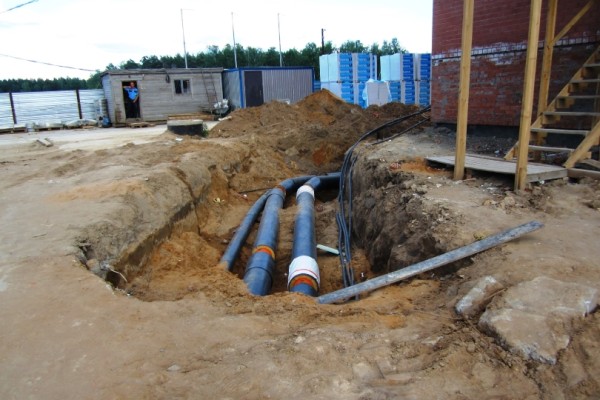
The procedure for organizing a connection to the central system is the same for large developers and private households
Among the disadvantages, it is worth noting the long preparatory period - it takes time to prepare and approve documents. The second disadvantage is the constant dependence on the condition of the city highway. If the system was built several decades ago, then it is worth calculating the cost of installing an autonomous septic tank - connecting it to an emergency system may be too expensive. Difficult terrain when the pipe is located above the site can significantly increase the cost of organizing drainage. In this case, they will organize the connection of the private pressure sewer system to the public one.
Alternative to city sewerage: autonomous septic tank
An alternative to city sewerage is the installation of an autonomous cleaning system. Septic tanks for country houses They are produced in finished form; you can also build wells yourself and equip them with filter systems. It is more profitable to install a private sewer system on the site if the main line is too far away or the pipe is in poor condition.
The advantages of connecting a house to a private sewer system - a septic tank:
- Full autonomy, independence from the state of the highway.
- Lack of regular payments for wastewater disposal.
- Purified water can be reused for technical purposes.

The installation of a private treatment system may be limited by the type of soil - in rocks oversaturated with groundwater, a septic tank cannot be installed. The arrangement of the cleaning system is carried out according to strict rules, with a mandatory setback from a residential building, road, water source.
Connection to the central sewerage: problems and solutions
How to connect to the sewer without unnecessary red tape and with minimal investment? First of all, you need to find out about the type of central highway. Next, make a preliminary plan and calculate the costs. Only after this can work begin.
Types of organization of drainage of wastewater into the city sewerage system
Before connecting to a sewer pipe, you need to find out the type of centralized system from your local water utility. There are 2 main types of metropolitan networks:
- Separate sewerage. In such a system, a common pipeline is laid separately to receive liquid waste from residential buildings and other objects, and a city storm sewer network is installed to drain precipitation.

- Mixed type. In a system of this type, insertion and private sewer pipe from a residential building, and drainage from home drainage systems.

Mixed type of connection to one pipeline
It is more profitable to connect to a mixed system - only one project and technical document is developed to implement the diversion of all waste water from one house with a plot. With a separate type of central network, you will have to issue all permits and technical conditions separately: for the domestic and stormwater systems.
If it is possible to organize the installation of a drainage well, it is better to connect the household wastewater to a common pipeline, and drain the stormwater into its own tank. After purification, rainwater can be used for irrigation, filling a pond or pool, and washing.
Preparation of necessary documents
Before connecting to the central sewer system, you must have a package of technical documentation and a permit in hand. You can handle the paperwork yourself or entrust all the paperwork to companies that specialize in the installation and maintenance of drainage systems. The service fee is worth the time spent collecting and completing paperwork.
Anyone who decides to organize the connection themselves will have to:
- Contact an expert surveyor and order an issue detailed plan plot with a house and a schematic representation of the planned sewer network.
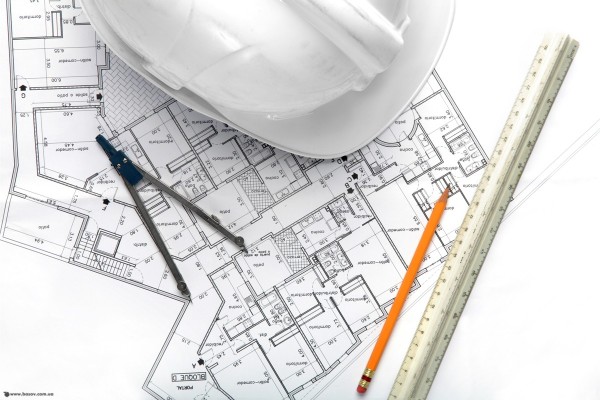
From the authority responsible for the operation of communications, order the development and issuance of technical conditions for connection
- Based on data from the technical specifications and information from the developed plan, designers create a project for connecting the house to water supply and sewerage.
The finished project must be approved by the architect and the responsible specialist of the local water utility. The organization that will carry out the work is approved. The place and time of work are also agreed upon by the water utility - installation cannot be carried out without a representative of the organization.
Preparing for insertion: organization of work
To connect a house to a central sewer system, it is necessary to lay a pipeline from the drain outlet from the house to the tapping point. According to the developed project, a trench is dug. Be sure to maintain the level of inclination of the pipe so that the entrance to the inspection tank is above the drainage point from the well.
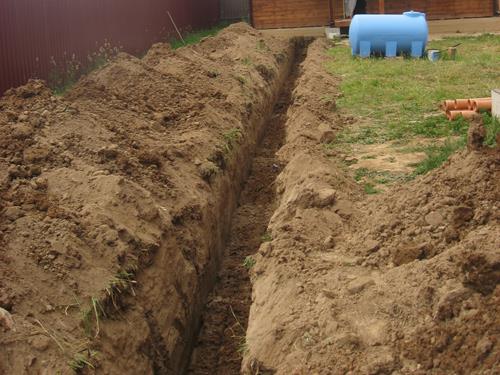
A trench is dug on a slope
The slope of the pipe cannot be less than 1 - 2 cm for every meter of straight pipe. It is better to double-check the compliance of the slope several times. If the slope is too small, water will stagnate in the pipeline. If the slope is too strong, water will be discharged quickly, and grease and thick impurities will remain on the walls - this will lead to constant blockages.
In a dug trench, it is advisable to equip an insulating layer - line the bottom with concrete blocks, or lay a pipe with insulation. Non-rotting synthetic materials are used as thermal insulation: polyurethane foam, PVC couplings, non-woven winding. In loose soil, the walls can be strengthened by pouring gutters along the formwork for laying the pipe. This approach will protect the pipe from destruction and the walls from crumbling. If repairs are necessary, access to insulated pipe easier to provide.
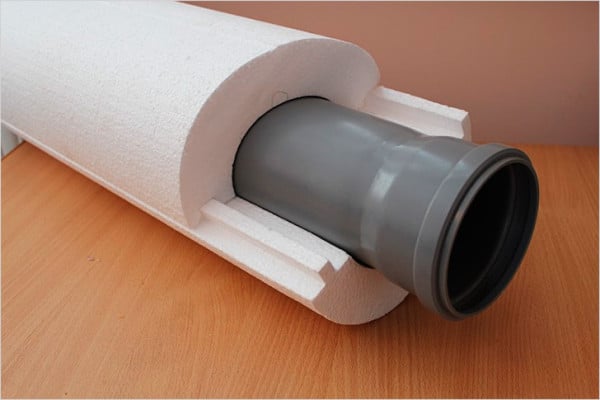
Foam insulation layer
To assemble a local pipeline to the point of entry into the collector, plastic moldings with sockets at one end are used.

Pipes prepared for connection
The connection is made with a socket towards the flow. No additional insulation of joints is required: the pipes at the joints are equipped with factory-made frost-resistant seals.
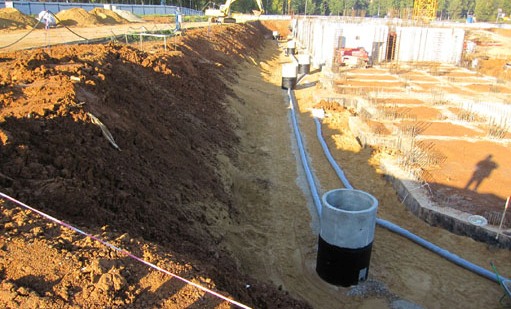
It is advisable to lay the pipeline in a straight line
Select the laying path with minimum quantity sharp turns and elevation changes. High angle bends are potential clogging areas. If it is impossible to avoid turning the pipeline at an angle of up to 90°, an inspection tank is installed in this place. The container is a concrete or plastic well with a hatch.

In places of branches and large angles inspection tanks are installed around the turn
The tank is used for preventive inspection of the condition of local pipes and for repairs and cleaning of the system.
Connection and maintenance
After finishing work on connecting the elements private system, you can connect to the street sewer. Be sure to invite an employee of the organization responsible for the operation of the highway section.
2 ways to connect to the central network:
- Use a piece plastic pipe with a special pipe. The joint is sealed with moisture- and frost-resistant sealants.
- Insertion with adapter. The cost of a special adapter is quite high, but its design is more durable. The adapter is a durable monolithic plate with bolts and a nozzle according to the diameter of the incoming pipe. A hole is formed in the pipeline, a pipe is put on the local pipe and the structure is connected by tightening the bolts.

Adapter for connecting a local pipeline to a central one
After completing the work and checking the tightness of the tie-in, the water utility representative signs a drainage agreement with the owner of the house.
Stormwater system: methods for arranging drainage
Difficult question– how to connect the drainage of a private residential building to the city sewerage system. After all, inserting storm drains into separate sewers is prohibited. It is necessary to develop separate conditions and conduct the pipeline to the general storm system. Most profitable option- connection to a mixed sewer. The work can be combined and immediately bring household and drainage pipe to the network.
Connection to the city storm water main
There are 3 ways to ensure rainwater drainage from the site:
- Insertion into a city highway.
- Lead drainage system into the ground. Such a decision can lead to constant erosion of the soil and flooding of one’s own and neighbors’ basements.
- Creating your own drainage system with a cleaning tank. The water is discharged into a container with filters, and the purified water is removed for reuse.
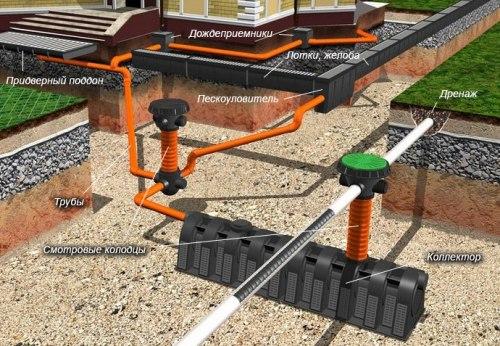
Connection to the central sewer network
To connect to the city stormwater system, documentation is drawn up at the preparatory stage, in the same way as for domestic wastewater drainage. The pipe is laid at an angle from the house to the entrance to the network. Use plastic pipes of smaller diameter.
The disadvantage of connection is the duration and organizational complexity of the procedure, dependence on the condition and cleanliness of the city pipe.
Autonomous system for a private home
The optimal solution for a private home is the arrangement of a drainage system. Water from the ground surface is pumped into drains and supplied through pipes to the receiving tank. A well equipped with filters is connected in series to the next container to collect purified water.

Autonomous storm drain: water is reused
Such storm drain has advantages:
- Rainwater collection is organized throughout the entire area of the site - in the yard, in the recesses the soil will not be washed away and water will not stagnate.
- The effectiveness of the system depends only on the correct installation and correct calculation of the volume of the receiving tanks.
- Autonomy: no need to pay for rainwater drainage or collect documents.
Pressure sewer connection: system features
How to connect to the central sewer of a private house located on a plot in a recess? To organize drainage in difficult areas, pressure systems are installed.
Technical features of arrangement and advantages of pressure sewerage
When it is not possible to directly lay pipes to the central collector or pipe due to rising terrain, it is necessary to equip a system with forced pumping of liquid between tanks. This type of sewer is called pressure sewer.

Scheme of arrangement of local pressure sewerage
The drainage system consists of elements:
- Receiver divided into a settling tank and a pumping compartment. The first tank receives water from the home drain pipe. The withdrawal chamber is equipped with powerful pumping equipment. From the reservoir, liquid is pumped through a pipeline to the next well.
- Inspection well. Water from the sump tank enters the inspection well under pressure. Through the drain, wastewater flows into the common city pipe along the gravity line.
The installation of such a cleaning system is justified if it is possible to organize the simultaneous connection of several houses in order to reduce costs. Before deciding to connect, it is worth considering the possibility of installing an autonomous cleaning network.
Video: cut into the city system
A detailed report on the work of laying pipes and connecting the home system to the public main.
Choosing the type of connection to the city sewer, or making a decision about arranging a private treatment system is best made only after consultation with professionals. Specialists know what condition the central pipeline is in, how much the project will cost, and how much it will be possible to save. You cannot carry out the work yourself. And for unauthorized tapping you will have to pay a fine. To insure yourself against troubles, it is better to entrust the entire process to a construction organization - this will speed up the paperwork stage and guarantee the uninterrupted operation of the sewer system.
Connecting a private house to a central water supply (CV) is the most economical and convenient way organization of housing water supply. The only drawback of this option is the need to obtain a number of documents and permits, since unauthorized tapping into the central water supply is illegal.
In this article we will look at the procedure that needs to be performed to arrange a central water supply for a house, cottage or cottage. Will also be considered necessary documents and recommendations were given on how to do all the work yourself.
1 What do you need to know before connecting to CV?
Among the advantages of connecting a private house to a central water supply, we highlight a serious reduction in the costs of organizing and operating a water supply - the construction of a well or a well will not only cost more at the stage of their development, but will also be accompanied by the costs of repairing and cleaning such sources in the future.
Also, the city water utility provides constant water quality - this statement is not fully true for all regions, but if there are no problems with this in your area, then the only thing you will need to purify the water is a regular tabletop filter.
Connecting to the water supply system is quite simple. You only need to collect the necessary technical acts and permits, after which a pipe is drawn from the central water supply to the house, which is laid below the freezing level of the soil.
If the water pressure provided by the water utility is satisfactory, you won’t even need to install a booster pump. An additional advantage will be the ability to connect to a central sewer system, which is necessary for discharging domestic wastewater. If this is not possible, the sewer installation work will need to be done with your own hands.

However, there are often situations when connecting to a centralized water supply can be problematic. The key factor is the outdated water supply system, which is designed for a small number of users and is not able to provide sufficient water supply pressure. In cases where a thin stream of water flows from the tap, you can forget about the normal operation of the column, boilers, washing machines and other equipment.
You can increase the pressure by installing a special pump, which is mounted on the pipe and automatically turns on when water consumption points are operating. Keep in mind that when arranging an autonomous water supply for a private house from a well or well, a pump will be required in any case.
Another problem of the central water supply can be low-quality water, which is not properly treated by public utilities. The other side of the coin is water, overly chlorinated water. Here you will need a good filter, or complex system water treatment
1.1 Required documents and connection procedure
To connect a central water supply to your house or dacha, you will need to collect the following documents:
- certificate of work for laying a pipeline;
- certificate for hydraulic testing of the system;
- act of flushing and sanitary cleaning of the water supply system;
- certificate for installing the meter.
Direct work on bringing water supply to the house is carried out by water utility specialists or a licensed organization, but if for some reason you do everything yourself, then you will additionally need to obtain certificates for carrying out hidden work on excavation, backfilling of the trench and adding sand.

Let's consider the sequence of actions when connecting:
- We contact the “Land Registration Center” to obtain a private homeownership plan (scale 500 to 1). It is important that it indicates the location of all underground communications on the site.
- Having a plan in hand, we go to the district water utility and submit the appropriate application; in a month you will receive technical connection conditions, which indicate the insertion point, pipe diameter and similar nuances.
- With technical specifications and documentation for private house We contact the SES, where we receive a conclusion on the legality of connecting to water supply networks.
- We take the specifications to the design organization, where they make the project for us (if such services are available in the city water utility, the project can be ordered from them). The resulting project must be registered with the SES.
The red tape with documents ends here, all that remains is to contact the water utility and get a list of licensed organizations that can lay and connect the water supply. Installation of metering devices and their commissioning is carried out directly by water utility specialists.
1.2 Features of connecting a house to a central heating system (video)
2 Work on laying and connecting water supply
If you have the appropriate permission, then everything installation work you can do it yourself. The central water supply is a pipe with a diameter of 100-500 mm, which can be connected to in two ways:
- welding method;
- use of an overhead clamp.
When using the welding method, the nearest shut-off valves in the central pipeline section are closed, after which a hole of the diameter specified in the project is cut out on the pipe, to which a thread (coupling) is welded. A full-bore valve is mounted on the coupling and a supply pipe is drawn from it to the house.
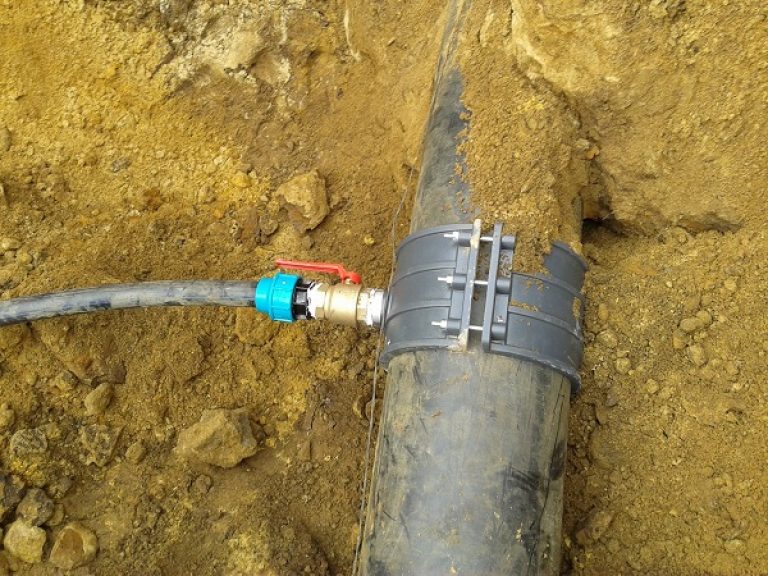
On outdated central networks, shut-off valves may be missing or in a faulty condition, which leads to the need for tapping under pressure. You can independently drill a pipeline through which water circulates only under pressure working environment up to 4-5 Atm.
Insertion using overhead clamps is carried out when connecting to pipelines made of polymeric materials - polypropylene and polyethylene pipes. To do this, the water is shut off and a rubber or silicone expander is placed on the pipe in the place where the hole will be drilled. Next, a clamp is applied and fixed (tightened with bolts), to which the thread is welded, the tap is mounted and the pipe is connected. In addition to the screed, it is advisable to fix the clamp using special epoxy adhesives that prevent it from moving during the process. thermal expansion pipes.
2.1 Installation of water supply inside the house
After water supply has been installed in the house, it is necessary to draw up a diagram of the distribution of water pipes inside the building. When choosing a scheme, you need to consider the following factors:
- number of water consumption points;
- the presence of filters that reduce circulation pressure;
- number of water consumption points and distance between them;
- total length of internal water supply.
In practice, two circuits are most often used - series (tee) and collector. The collector circuit shown in the image is suitable for small houses. It consists in the fact that one pipe is drawn from the water intake point, to which all water consumption points are connected. Its disadvantage is a reduction in the circulation pressure at the end of the circuit, however, this problem can be solved by installing a circulation pump.

The collector scheme is suitable for houses of any size, since it involves installing a collector at the water intake point, from which individual pipes are routed to each water consumption point. A shut-off valve must be installed at each section of the collector so that, if necessary, the water supply to the emergency area can be shut off.
For water distribution inside the house, it is best to use polymer or metal-plastic pipes - this is a relatively cheap and durable option that is superior to steel analogues in all performance characteristics. It is rational to connect the shower cabin to the water supply, as well as water heaters and boilers, using elastic plastic corrugated pipes.
If cold and hot water supply pipes run parallel, then the cold one should always be the bottom one, so condensation will not form on it. Most frequent mistakes when installing internal water supply are:
- passing all pipes through one hole in the wall, without observing the minimum permissible distance between them;
- neglect to install shut-off valves in front of plumbing fixtures;
- lack of thermal insulation of hot water supply pipes when they are placed in walls or an unheated underground.
And don’t forget that according to the unspoken rule for faucets hot water should be connected on the right, and the cold one on the left!






